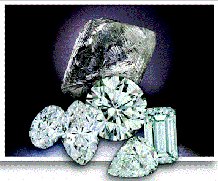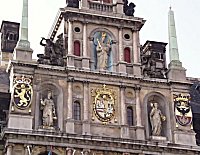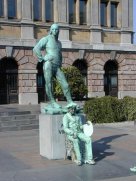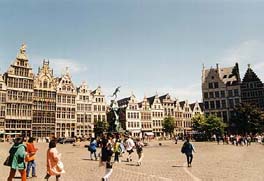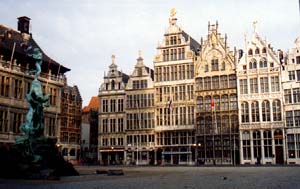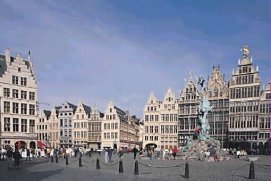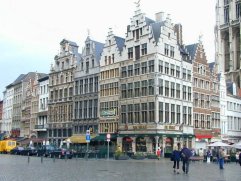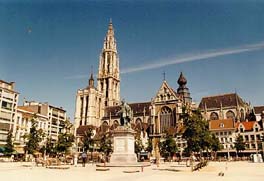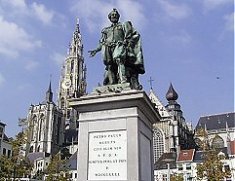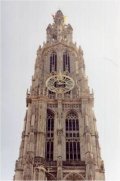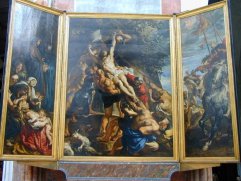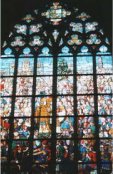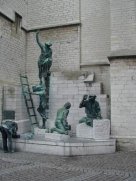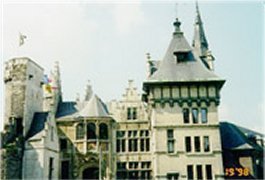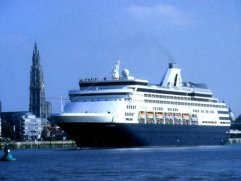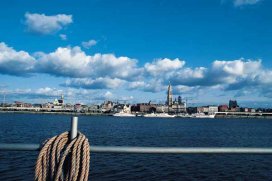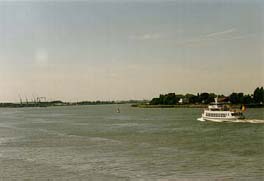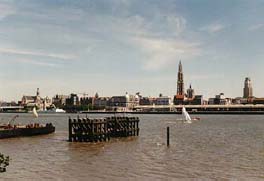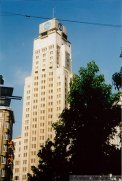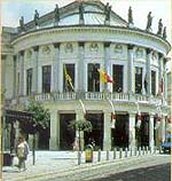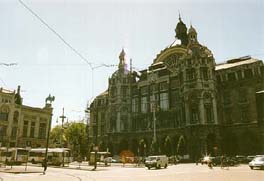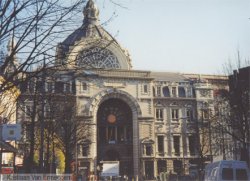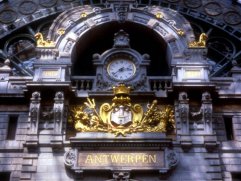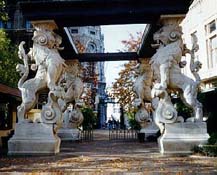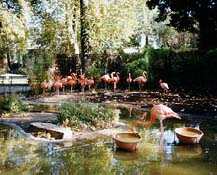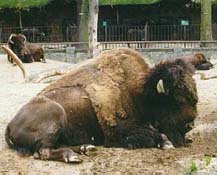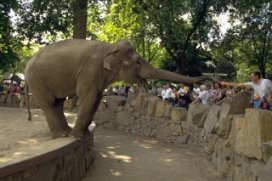Image 1/42
Diamonds
Antwerp is not only a port and a cultural city: Antwerp is the world centre of diamond processing and of trading. If diamonds really are a girl's best friend, than a lot of ladies will not leave out a visit to the diamond district around the Railway Station. Over 80% of the world's diamond production is traded via Antwerp. The diamond industry has it's own district in the center of the city: it is the most secured place in town ! Its heartbeat is Pelikanstraat and Appelmansstraat.
Image 2/42
|Diamonds
The term Antwerp cut is internationally recognized in the diamond trade as a hallmark of quality. Any diamond rough in the world that is out of the ordinary, especially large, or requires special cutting comes to Antwerp to be cut by the masters. Five centuries of advancing technology, and the wide availability of good training support the Antwerp tradition of utmost quality.
Image 3/42
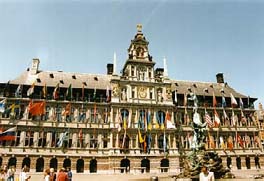
Het Stadhuis - City Hall
The City Hall, built from 1561 - 1564 (architect Cornelis Floris de Vriendt). A lot of City Halls in Flanders aren`t used any more, most of them are only used as monumental decoration or as museum. In Antwerpen, the city hall is still used for the reason that it was built so many years ago, the administrative centre of the city. It is also possible to visit this City Hall. This City Hall still radiates the pride and glory of Antwerpen`s Golden Century. The "Stadhuis" was erected during a time when Antwerp was near the height of its power. Its leaders decided the city needed an administration building befitting a powerful financial and trading center. This building is the result. While small, it is intricately detailed with symbols of might and power throughout. But it's not as complex as other buildings of the time. It is built in Renaissance style, based on Gothic style, perhaps a harbinger of the Spanish invasion which was to come just a few years after it was completed, and cause half of the city's population to flee.
Image 4/42
Het Stadhuis - City Hall (detail)
The middle section is decorated with the statues of Lady 'Justitia' and Lady 'Prudentia'. The weapons are those of the Duchy of Brabant (black field with gold lion), the coat of arms of the Spanish King Philip II (middle) and of the Markgrave of Antwerp (right). Above the weapons is a Madonna statue, which is obviously too big for the niche it stands in. It was put there by the Jesuits during the Counter-Reformation to replace a Brabo statue, considered to be too heathen during the troubled times of the religious wars at the end of the 16th century and the beginning of the 17th.
Image 5/42
Statue "De buideldrager
At the left side of City Hall you see the statue `De buideldrager` (The Bag Carrier), on this statue you can read `Arbeid Vrijheid` (= Labour Freedom), this is a monument for the harbour workers.
Image 6/42
Grote Markt (Town Square)
This is the center of the old section of Antwerp, and was the hub of activity for more than a thousand years. At one time Antwerp and Paris were the largest and most important cities in Europe. It was then that this square, lined with beautifully ornamented houses, was the focus of a bustling metropolis. Now that Antwerp's Golden Age has passed, the square is much quieter; but is still culturally significant as a gathering place for special events. While the Stadhuis (city hall) is the focus of the square, a statue of Silvius Brabo erected in 1887 dominates the opposite end. He is frozen in time, forever hefting the severed hand of Druon Antigon toward the Scheldt River.
Image 7/42
16th-century Guildhouses
Detail of the Guildhouses with in front Brabo statue.The triangle shape of the Grote Markt points out the Frankish roots of this square. This square is surrounded by Guildhouses from the 16th and 17th century.
Image 8/42
16th-century Guildhouses
Image 9/42
16th-century Guildhouses
These guild houses have richly decorated stepped gables and, which are mostly richly decorated with graceful pinnacles. Even the Spanish Fury in 1576 did not save the Grote Markt, many of the guildhouses did burn down, but soon they were rebuild.
Image 10/42
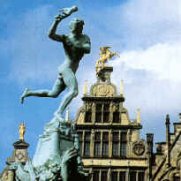
Brabo Fountain
Grote Markt - detail of Brabo~The Brabo Fountain in front of the City Hall. There is a mythological saga that tells that in the beginning of chronology , the curb in the Schelde river was dominated by the giant Druoon Antigoon, who claimed a heavy toll of all passing ships. The ones who refused to pay, well their hand was cut off. This ended when a Roman soldier Silvius Brabo killed the giant, he did cut off his hand and threw it into the Schelde river. From that moment this place was called Handwerpen (werpen = throwing), after sometime the "H" disappeared and the name Antwerpen was born. This is one of the stories about the name of this wonderful city. The statue of this legendary liberator can be seen on the Grand Market place, just in front of the City Hall. The true story about the name is that it is derived of the word "aanwerpen", this were spits of land in the Schelde river where ships could moor. And on one of these spits of land the city was born. The bronze statue (1887) is made by the Antwerp sculpture Jef Lambeaux.
Image 11/42
Groenplaats
Groenplaats with in the back "Onze-Lieve-Vrouw Kathedraal". The Groenplaats (Green Square) is dominated by Our Lady's Cathedral. In medieval times the cemetery of the cathedral was located here. Around the square are numerous restaurants and cafés where many famous artists spent their time. It's the most popular square. The square used to be a parking lot. But recently, the parking has been built underground, and the Groenplaats is rapidly finding back its charm of old. On warm afternoons the square can be really packed with people (tourists as wells as Antwerpians) who all enjoy a good beer (or something else) on the numerous terraces. Very beautiful is the facade of the 'Karbonkelhuis' at number 33. This former 'diamond house' is an example of the Renaissance style. The name of the house is derived from the diamond head decoration at the ground floor.
Image 12/42
Statue of Rubens
In the middle of the Groenplaats the statue of Rubens can be seen. It was made in 1843 by sculptor Geefs. Very beautiful is the facade of the 'Karbonkelhuis' at number 33. This former 'diamond house' is an example of the Renaissance style. The name of the house is derived from the diamond head decoration at the ground floor.
Image 13/42
Onze-Lieve vrouw Kathedraal - Cathedral of Our Lady
The Cathedral of Our Lady dominates the Antwerp skyline. As cathedrals go, this is a very large one; and it never reached its intended size. The original plan called for a cathedral three times as large, with nine naves and two towers. A fire in 1521 changed those plans, there was so much money needed to restore the building, that there was no more money left for the second tower. But still the Cathedral of Our Lady is the largest in the Low Countries. Its tower is an impressive 126 meters (404 feet) tall. Inside is a Carillon with 47 bells.
Image 14/42
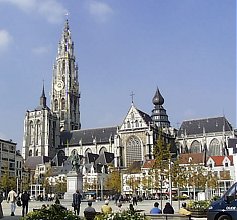
Onze-Lieve-Vrouw Kathedraal - Cathedral of Our Lady
Even with those dimensions, the largest of the three towers was never built. The Cathedral has borne the brunt of many centuries of turmoil. The area has repeatedly changed hands, and in 1566 the Calvinists devastated the Cathedral. In the 18th century, the French did the most damage. They stripped the Cathedral bare, broke up the floor, and sold off all of its great works of art. The Cathedral's foundation routinely scours the world's auction houses bidding on pieces of its own history. Today, many of those works are slowly being brought back home, and the Cathedral functions as a very well stocked art gallery. There are a number of paintings by Pieter Paul Rubens in the Cathedral. Several impossibly large works of art hang from the ceiling. Among them, the Triumphal Cross with Saint John and Our Lady, made in the 15th, 17th, and 19th centuries, respectively. Even the confessional (H.F. Verbrugghen 18th century) and the communion rail (L. Willemssens, 1680) are so well crafted and so intricately adorned that they are considered works of art. In addition to the altars, paintings, and statuary, the Cathedral is adorned with 34 immense stained glass windows.
Image 15/42
Onze-Lieve-Vrouw Kathedraal - Cathedral of Our Lady
Detail of the tower.~In addition to the altars, paintings, and statuary, the Cathedral is adorned with 34 immense stained glass windows. The one pictured here shows Saint Amand preaching in Antwerp. It was fashioned by E. Didron in 1872. For the curious, a spiral staircase will take you below the church where a small portion of the crypts has been excavated.
Image 16/42
Painting Rubens
The Cathedral has also a beautiful collection of paintings: amongst them are 4 of Rubens most important paintings: The Descent of the Cross (1612), The Elevation of the Cross (1610), The Assumption of the Virgin Mary (1625-1626) and The Resurrection. Rubens, himself, is buried in the nearby Church of Saint James.
Image 17/42
Glasraam - Stained-glass window)
The one pictured here shows Saint Amand preaching in Antwerp. It was fashioned by E. Didron in 1872.
Image 18/42
Buideldragers statue
Towards the Southern Tower you can see a group of statues to honour the architect Pieter Appelmans. Here you see Buideldragers (Bag Carriers)
Image 19/42

't Steen
On the waterfront stands the gatehouse of a medieval fortress "Het Steen". This is the oldest still existing "building" in Antwerpen (ca 1200). In fact these are the remains of a much bigger fortress, that was built to protect the walled inner city. It was probably built as a part of the fortification around the city in the 13th century.It was probably built as a part of the fortification around the city in the 13th century. It was also the house of the Burgrave. The cross opposite the entry recalls to the time that Het Steen was used as a prison (from 1549 until 1823). In front of this Cross the convicts who were sentenced to death made their last prayer. The castle "Het Steen" (Dutch word for 'stone') is called that way because it was one of the earliest buildings in Antwerp constructed with stones (at a time when most houses were still built with wood). The Antwerp Steen has been renovated numerous times. In 1520, during the reign of Charles V, the castle was renovated by the architects Keldermans and De Waghemakere. The chapel which forms a loggia above the entrance dates from this period. It was again renovated in 1889-1890 and a Neo-gothic wing was added to the building.
Image 20/42
't Steen
At the entrance a relief statue can be seen of a man with spread out legs. This statue also used to have a very large penis and was therefore venerated by numerous women looking for a cure against infertility. The Jesuits found the statue too obscene in the 17th century ... and off went the decoration of the statue ! As from 1862 Het Steen is used as a museum. Since 1952 it serves as the National Maritime Museum (Het Nationaal Scheepvaart museum), comprising old and modern ship models, engravings, maps, maritime instruments, ship models, paintings, pictures, maritime utensil, ship parts, instruments, decorations, etc. Next to the castle are the large storage halls of the 19th century harbor. Here can be seen numerous vessels and boats which belong to the Maritime Museum.
Image 21/42
Lange Wapper
The entrance to the Steen is guarded by the 'Lange Wapper' statue. This statue was made in 1963 by Albert Poels and represents a legendary person called Lange Wapper, the Antwerp version of the boogie man. He terrified children and drunks. Lange Wapper, a legendary figure, who was feared by many inhabitants of Antwerpen. The name 'Lange Wapper is now also used for a new fountain in the river Scheldt.
Image 22/42
Cruise terminal
Ever since Antwerp has a modern automatic gangway, the cruise shipowners have been finding their way back to the city on the Scheldt. The demand for interesting ports is mounting as a result of the growing success of cruises and the strong increase in numbers of European cruise tourists. By mooring barely 300 metres from the historic city centre, Antwerp’s role as a cruise city is guaranteed.
Image 23/42
Scheldt
Scheldt : roadstead of Antwerpen
Image 24/42
Scheldt
Scheldt : view from the right bank
Image 25/42
Scheldt
Scheldt : view from the left bank ~ (roadstead of Antwerpen)
Image 26/42
"Boerentoren"
"Boerentoren" is 97 m high and is considered by most as the first 'skyscraper' in Europe. It was finished in 1932 (art deco style). The architects were Smolders, Vanhoenacker and Van Averbeke. Nowadays this tower is the seat of the Kredietbank-Cera Holding, one of the important Belgian banks. The Antwerpians call it the "Boerentoren" (= farmers tower) because the farmers were the most important clients of the Kredietbank in the first half of the 20th century.
Image 27/42
Bourla Schouwburg
This `Théatre Royal` was projected by the municipal town planner Pierre Bourla in 1834. For more then a century, opera and drama was performed here for the Frenshspeaking Antwerp bourgeoise and then "Het Toneelhuis" moved in.
Image 28/42
Bourla Schouwburg
Theater Bourla
Image 29/42
Central Station
The Central Station is a magnificent creation. Known as the "Railway Cathedral" to locals and admirers from afar, this station brings the mystery and excitement of a bygone era of rail travel to life today. It is appropriate that this is such a grand expanse. Still, "Cathedral" may be a bit of a misnomer. It has been compared to the Taj Mahal, and perhaps "palace" would be a better analogy since it is made from 20 kinds of marble and stone, and even the cafeteria is renouned for its decor. Antwerp is home to the oldest railway line in Belgium (The Brussels - Mechelen - Antwerp line).
Image 30/42
Central Station
From the outside it can be mistaken for a cathedral because of its huge dome. It might look more like a castle or government building if six of its eight towers weren't demolished years ago. The vast glass and metal vault which shelters trains and passengers alike is 185 meters long, and 44 meters high. The station is so beautiful it was featured in an episode of Agatha Christie's "Poirot." Except, on television it played the role of the Brussels Station, not an insignificant slight to Antwerp.
Image 31/42
Central Station
Detail
Image 32/42
Zoo (Antwerpen)
Image 33/42
Zoo (Antwerpen)
Entrance
Image 34/42
Zoo (Antwerpen)
Flamingos
Image 35/42
Zoo (Antwerpen)
Bison
Image 36/42
Zoo (Antwerpen)
Sea-lion
Image 37/42
Zoo (Antwerpen)
Pingiuns
Image 38/42
Zoo (Antwerpen)
Tigers
Image 39/42
Zoo (Antwerpen)
Elephant
Image 40/42
"Pralines"
The famous Belgian Chocolate
Image 41/42
"Bolleke"
This is somewhat the unofficial symbol of Antwerp.'Bolleke' is the name given to the De Koninck Beer, the most typical and popular alcoholic drink of the city. The name means 'little ball' and refers to the glass from which the delightful reddish beer is drunk.
Image 42/42
Fashion City
If you are following the fashion scene in the past 10 years, you have surely heard of "The Antwerp Six", all of whom graduated from the Academy of Antwerp in the early eighties. Ann Demeulemeester, Martin Margiela, Dries Van Noten, Walter Van Beirendonck, Dirk Van Saene and Dirk Bikkembergs are all established fashion names now. Well, they are the guys who made Antwerp Mode so popular. Many of them stay in this city and continue to create new fashion. At the same time, more and more young designers are coming out from the Fashion Academy in Antwerp where the original ones have graduated. Between them they have made Antwerp a regular stopping-off place for the fashion world between Paris and London.


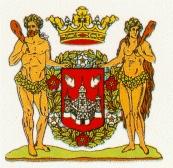

 WebCam Antwerpen
WebCam Antwerpen